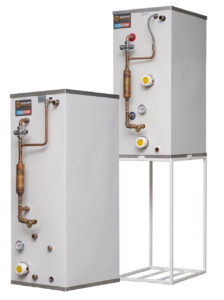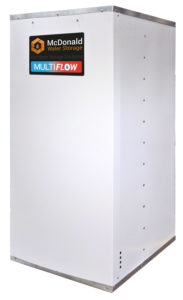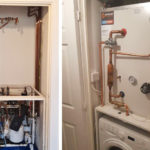Jason Hobson, Divisional Director at McDonald Water Storage, discusses why thermal stores offer an ideal solution for local authorities.
Thermal stores have been an effective and highly efficient hot water solution in the UK for almost 40 years. However, it is no surprise that many installers in the private sector decide not to use thermal stores and just to go with a straight replacement of what is there or simply revert back to an unvented cylinder alternative.
Thermal store popularity is on the rise however, particularly in apartment applications, as they overcome many of the frustrations both installers and local authorities have with unvented cylinders, including the hidden costs of installation via the difficult G3 requirements, and ongoing maintenance.
So, why are more installers and local authorities looking at utilising thermal stores to simplify the installation process and improve the finished solution with a fit and forget hot water thermal store?
Sometimes it is out of necessity, for example in projects where commercial buildings are being converted into apartments and you need to deliver a mains pressure hot water solution. It is almost impossible to install the discharge pipework to comply with G3 of the building regulations necessary for unvented solutions, without the requirement of screeding the pipework under the floor to allow the fall necessary prior to discharging into a high temperature soil stack.
Other times, it’s because it is just the best solution for the project. For instance, when incorporating renewable or multiple energy inputs or the cylinder needs to be located in a specific part of the property where the space available cannot accommodate the ‘standard’ size offering.
From a health and safety perspective, the benefit of a legionella free and scald protected system, makes life easier in years to come. Having a fit and forget solution with reduced installation complexity requiring no costly annual maintenance.

Turning the traditional approach on its head
With a thermal store, the traditional approach to generating hot water is reversed. So, instead of storing hot water in the cylinder under pressure, which is then used for taps and showers when required, the thermal store acts more like a battery storing the energy from any fuel source when it is cost-effective, and then providing hot water and heating when it is needed in an inherently safe vented store.
The mains pressure hot water is generated by passing the mains pressure cold water through the highly efficient internal coil, and the heating by sending the stored water around underfloor or radiator system.
Thermal store diversity
We are all used to hearing how energy can be generated in a property and stored in a battery through PV panels or when low-cost electricity tariffs are available, for use by the household when required to power electrical products. The thermal store works on the same principal. It is widely recognised as the optimal solution for incorporating renewable energy inputs thanks to its ability to harness the energy as it is generated just like a battery and store it until it is required and then transfer the heat into heating and hot water on demand.
With the emphasis on reducing carbon, and the introduction of low-cost flexible electricity tariffs which utilise the energy as it is generated, for storage, when demand is low, or even from suppliers of the traditional off-peak supplies. Thermal stores are utilising the electricity not just as a backup, but as an important heat source to enable the load shifting of energy demand. This provides a fantastic opportunity in apartments as electrification is required, enabling the costs to be competitive with that of a traditional gas system.
Central plant benefits
The HWA (Hot Water Association) reinforced the message regards the benefits of using hot water storage within heat network schemes whether central plant or district heating, with their publication Design Guide for Stored Hot Water Solutions in Heat Networks, which lists no fewer than 22 advantages of using stored hot water over instantaneous systems.
With many technical challenges surrounding boiler sizing, diversity requirements and pipework infrastructure, the significant benefits which localised storage can provide should be considered.
Having localised storage means that the boiler size and therefore pipework infrastructure can be dramatically reduced in, saving money, and building the efficiency of the system by smoothing out the running load of the boiler. With this in mind, the thermal store provides the perfect option to old heat interface units commonly installed in conjunction with central plant boilers.
In addition, a thermal store which is specially designed for central plant applications, will incorporate an immersion heater to heat the complete store. This enables the central plant system to be turned off in summer months when heating is not required or for routine maintenance. The store is then heated electrically for the properties domestic hot water.

Tried and tested
A recent project through Cenergist for the London Borough of Hammersmith & Fulham utilised the thermal store solution, where they replaced existing Elson tanks following resident complaints of low water pressure and failing shower pumps, with the MULTIflow SB units from McDonald Water Storage.
Julian Campbell of Cenergist said: “The Thermal Store solution provided by McDonald Water Storage has performed excellently providing mains pressure to all hot water outlets including a thermostatic shower and provided a seamless offering with minimal disruption. We will certainly continue to use this product on future installations where the need arises.”
McDonald Water Storage is a leading manufacturer of thermal stores with a range of thermal stores to suit every project with the MULTIflow thermal store for the contract market, the CUBEflow thermal store for space restricted applications, the infinitely flexible THERMFLOW thermal store bespoke range offering multiple heat source inputs and finally the ELECTRAflow thermal store for electric heating and hot water.
For more information and more tips on the use and application of thermal stores visit www.mcdonaldwaterstorage.com.









